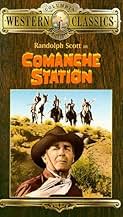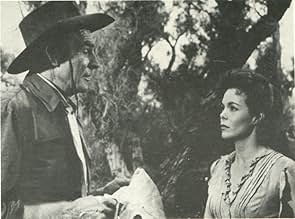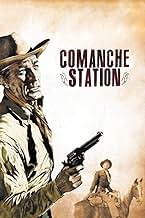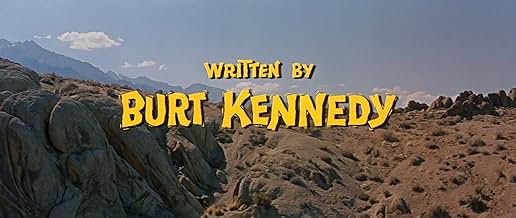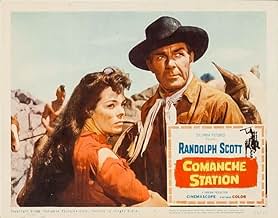AVALIAÇÃO DA IMDb
7,0/10
4,8 mil
SUA AVALIAÇÃO
Adicionar um enredo no seu idiomaA man saves a woman who had been kidnapped by Comanches, then struggles to get both of them home alive.A man saves a woman who had been kidnapped by Comanches, then struggles to get both of them home alive.A man saves a woman who had been kidnapped by Comanches, then struggles to get both of them home alive.
P. Holland
- Lowe Boy
- (não creditado)
Foster Hood
- Comanche Lance Bearer
- (não creditado)
Joe Molina
- Comanche Chief
- (não creditado)
Vincent St. Cyr
- Warrior
- (não creditado)
Avaliações em destaque
Comanche Station is the last of several films Randolph Scott made for Budd Boetticher with Columbia pictures. This would have been his last film, but for being lured to do just one more, the immortal Ride the High Country.
The film combines elements of The Naked Spur and Two Rode Together and blends them successfully. Scott is a man with one obsession, to get his wife back from the Comanches who kidnapped here ten years earlier. Whenever he hears of a white woman being put up for trade by the Indians he heads out with trade goods and buys her in the hopes of finding his beloved.
On this trip he ransoms Nancy Gates away from the Comanches. Later on he runs into an old enemy Claude Akins traveling with two young guns, Richard Rust and Skip Homeier. It seems as though Nancy's husband has put up a ten thousand dollar reward for her.
Akins is a truly malevolent figure, a scalphunter who kills Indians and sells their scalps for bounty. Unfortunately the two have need of each other in hostile Indian territory.
Randolph Scott's western heroes usually have an edge to them, they are not pure heroes as Joel McCrea's are. But in this film he's poaching on McCrea's territory in gallantry. His behavior towards Nancy Gates is at all times chivalrous. I wouldn't be surprised if there was a medieval origin to the plot of Comanche Territory.
Had Scott not come back to do Ride the High Country, Comanche Station would have been a good film to go out on.
The film combines elements of The Naked Spur and Two Rode Together and blends them successfully. Scott is a man with one obsession, to get his wife back from the Comanches who kidnapped here ten years earlier. Whenever he hears of a white woman being put up for trade by the Indians he heads out with trade goods and buys her in the hopes of finding his beloved.
On this trip he ransoms Nancy Gates away from the Comanches. Later on he runs into an old enemy Claude Akins traveling with two young guns, Richard Rust and Skip Homeier. It seems as though Nancy's husband has put up a ten thousand dollar reward for her.
Akins is a truly malevolent figure, a scalphunter who kills Indians and sells their scalps for bounty. Unfortunately the two have need of each other in hostile Indian territory.
Randolph Scott's western heroes usually have an edge to them, they are not pure heroes as Joel McCrea's are. But in this film he's poaching on McCrea's territory in gallantry. His behavior towards Nancy Gates is at all times chivalrous. I wouldn't be surprised if there was a medieval origin to the plot of Comanche Territory.
Had Scott not come back to do Ride the High Country, Comanche Station would have been a good film to go out on.
A magazine article recently cited this movie as an underrated western. I certainly agree. Randolph Scott made his best westerns in the latter part of his career, and this is one of those. The movie examines the old west moral code of right v. wrong and raps up with a surprising twist ending that gives cynicism a kick in the rear end. Not a big splashy western, but a solid little one.
This is the final film that was directed by Budd Boetticher and starring Randolph Scott. Like their previous collaborations, they both work together to produce Westerns that manage to rise above the mediocre norm. In this film, a fairly typical plot idea is executed very well--with a grace and style that make the film well worth seeing.
Randolph Scott, as usual, plays a nice but tough guy. He's brave enough to come into a Comanche stronghold in order to negotiate for the release of a White woman kidnapped by the tribe. However, trouble is in store when three drifters come upon Scott and the woman. It seems that the leader of this group (Claude Akins) is a real rogue and plans with his men to kill Scott and the woman. It seems that the woman's husband has offered a reward for her--and it can be collected dead or alive! So what did I like about the film? First, as usual, Randolph Scott is amazing. He plays the perfect cowboy hero--tough, slow to speak and anger but also a decent man through and through. Plus, he's much more believable than the bigger than life characters John Wayne usually played. I loved Wayne's films, but he was always too tough and too in command. Scott is much more like a very capable 'everyman' character. Second, as usual, Boetticher deliberately underplays the action--producing a muted but also quite believable film. Third, the film had a really nice ending--quite the twist.
You can't do a lot better than a Scott/Boetticher western. While this isn't their best, it certainly is quite good.
Randolph Scott, as usual, plays a nice but tough guy. He's brave enough to come into a Comanche stronghold in order to negotiate for the release of a White woman kidnapped by the tribe. However, trouble is in store when three drifters come upon Scott and the woman. It seems that the leader of this group (Claude Akins) is a real rogue and plans with his men to kill Scott and the woman. It seems that the woman's husband has offered a reward for her--and it can be collected dead or alive! So what did I like about the film? First, as usual, Randolph Scott is amazing. He plays the perfect cowboy hero--tough, slow to speak and anger but also a decent man through and through. Plus, he's much more believable than the bigger than life characters John Wayne usually played. I loved Wayne's films, but he was always too tough and too in command. Scott is much more like a very capable 'everyman' character. Second, as usual, Boetticher deliberately underplays the action--producing a muted but also quite believable film. Third, the film had a really nice ending--quite the twist.
You can't do a lot better than a Scott/Boetticher western. While this isn't their best, it certainly is quite good.
Nice film regarded in certain Western lover circles as a cult classic. She was not the white woman he'd bought , but she was the white woman he was going go keep. She was worth 5000 dollars alive or dead but she was easier to bring in dead . Here Randolph Scott is the loner Jefferson Cole, an obsessive, stubborn man hunting the last ten years for his wife abducted by the Comanches, who rescues instead another kidnapped woman, she is a pretty heroíne, Nancy Gates: an attractive and no mean actress, only yo find himself up against three reward-hungry outlaws : the leader : Claude Akins , and his hoodlum sidekicks : Skip Homeier , Richard Rust, all of them insist on accompanying them back to the spouse homestead, saying they need additional protection. However, Cody soon realizes that this nasty trio are after the reward money and are scheming an ambush .Then Cole ferries the kidnapped woman back to civilisation throughout dangerous ways chased by the violent Comanches .
Tipically tough Randolph Scott western from his later years in films made by Budd Boetticher with whom he played a lot of Western in the Fifties and early Sixties. Magnificently and splendidly written by Burt Kennedy with roles doomed from the start . It results to be a bleakly pesimist movie that gains warmth from moving pursuits , Indian attacks , a discreetly elegiac tone and gently ironical humour .It deals with a simple, and plain plot , a hero achieves rescue a woman and they fall in with three villains , in the capable hands of a trío of awesome uglies , excellently played by Claude Akins , Skip Homeier and Richard Rust.
A Ranown production by Harry Joe Brown and Randolph Scott, delivered by Columbia Pictures , Budd Boetticher made it in medium budget and being finely starred by a solid cast as well as competent filmmaking . It contains a colorful and brilliant cinematography in Technicolor by Charles Lawton Jr, showing barren, stark outdoors and rocky landscapes. As well as atmospheric and thrilling musical score by Mischa Bakaleinikoff. The motion picture was compellingly directed by Budd Boetticher . His first Western was the low budgeted The Wolf Hunters 1949 produced by Monogram. With Universal International Pictures Budd made The Cimarron Kid , Bronco Buster, Horizons West , Seminole , The Man from Alamo. In 1956 he directed Seven Men From Now , a Batjac production , it began a long collaboration with Scott . Following Tall T in 1957 , produced by Harry Joe Brown and Boetticher , Decision at sundown 1957 , Buchanan Rides Alone 1958 , Ride lonesome 1959 , Westbound 1959. Most of them written by Burt Kennedy and Charles Lang Jr and cameramen William Clothier and Charles Lawton Jr . Finally, Boetticher wrote Two mules for the sister Sara by Don Siegel and his ending Western : Dying proud produced by Audie Murphy. Rating 7/10. Better than Average. Well Worth Watching .
Tipically tough Randolph Scott western from his later years in films made by Budd Boetticher with whom he played a lot of Western in the Fifties and early Sixties. Magnificently and splendidly written by Burt Kennedy with roles doomed from the start . It results to be a bleakly pesimist movie that gains warmth from moving pursuits , Indian attacks , a discreetly elegiac tone and gently ironical humour .It deals with a simple, and plain plot , a hero achieves rescue a woman and they fall in with three villains , in the capable hands of a trío of awesome uglies , excellently played by Claude Akins , Skip Homeier and Richard Rust.
A Ranown production by Harry Joe Brown and Randolph Scott, delivered by Columbia Pictures , Budd Boetticher made it in medium budget and being finely starred by a solid cast as well as competent filmmaking . It contains a colorful and brilliant cinematography in Technicolor by Charles Lawton Jr, showing barren, stark outdoors and rocky landscapes. As well as atmospheric and thrilling musical score by Mischa Bakaleinikoff. The motion picture was compellingly directed by Budd Boetticher . His first Western was the low budgeted The Wolf Hunters 1949 produced by Monogram. With Universal International Pictures Budd made The Cimarron Kid , Bronco Buster, Horizons West , Seminole , The Man from Alamo. In 1956 he directed Seven Men From Now , a Batjac production , it began a long collaboration with Scott . Following Tall T in 1957 , produced by Harry Joe Brown and Boetticher , Decision at sundown 1957 , Buchanan Rides Alone 1958 , Ride lonesome 1959 , Westbound 1959. Most of them written by Burt Kennedy and Charles Lang Jr and cameramen William Clothier and Charles Lawton Jr . Finally, Boetticher wrote Two mules for the sister Sara by Don Siegel and his ending Western : Dying proud produced by Audie Murphy. Rating 7/10. Better than Average. Well Worth Watching .
Howard Hawks was once asked about his recipe for making a great film. His reply: "Three good scenes, no bad scenes". I would humbly add two other rules: A great film is one where no additional scene is needed, and no existing scene could have been cut. Few competent directors violate the first rule. The mark of a great director is the ability to follow the second. Many inferior directors are too shallow or too vain to understand this - they constantly strive to include superfluous or redundant scenes - Just To Make Sure You Got The Point - when it is wiser to let the audience decide what is important. John Ford was the master at this. Hawks, Wilder, Eastwood, also come to mind. With Commanche Station, Budd Boetticher showed that he knew how to distill a great story (with many elements of a Greek tragedy) to its most basic human elements - Obsession, Greed, Loyalty, Irony, and above all, Honor.
Not only did Boetticher direct a great film, Burt Kennedy (later to become a fair director himself) constructed a great script.
Some good scenes: A conversation between a woman who was taken captive by Commanches (and held for a time) and the stranger who has just paid her ransom... Nancy Lowe: If-if you had a woman taken by the Comanche and-and you got her back... how would you feel knowing? Jefferson Cody: If I loved her, it wouldn't matter. Nancy Lowe: Wouldn't it? Jefferson Cody: No ma'am, it wouldn't matter at all.
Or two friends, hired guns both, contemplating the need to commit a horrible crime for money: Frank: You want to go to work, do you? Dobie: Work? Frank: Making an honest living? Dobie: Oh, no, I don't think I could do that. I could cowboy some. Frank: Well, what will that get you? You work yourself to death for somebody and likely they will have to take up a collection to bury you.
Or a conversation between an honorable man and a young man trying to decide whether he will try to become one: Dobie: A saddle and a shirt, that's all Frank had. It sure ain't much. Jefferson Cody: Sure ain't. Dobie: It wasn't his fault, though. Jefferson Cody: No? Dobie: No, he never knew anything but the wild side. Jefferson Cody: A man can cross over anytime he has the mind.
As for the performances, they are uniformly good. Nancy Gates, Skip Homier, Richard Rust, and Claude Akins hit the right tone - never going too far for a laugh or a tear.
And Randolph Scott was perfect - A word I do not use lightly. Roger Ebert once said that Marlon Brando and Paul Newman started out on the same path: Both came on the scene in the early 1950s, both studied the Method, both looked good in an undershirt. But Brando went on to see what else he could throw in to his performances while Newman went on to see what he could leave out (Newman once said that he was dissatisfied with many of his early performances because "you could see the acting"). In Commanche Station, Randolph Scott provided the inspiration for such an approach. This is what makes a performance (indeed, a film) memorable - by distilling your performance to only that which is necessary, you allow the viewer to remember what is important to them, not what they are told should be important to them.
If I were held to only half a dozen westerns to be labeled as essential, this would be one of them (The others: My Darling Clementine (1946), Shane (1953), The Searchers (1956), The Man Who Shot Liberty Valance (1962) and Unforgiven (1992)).
Not only did Boetticher direct a great film, Burt Kennedy (later to become a fair director himself) constructed a great script.
Some good scenes: A conversation between a woman who was taken captive by Commanches (and held for a time) and the stranger who has just paid her ransom... Nancy Lowe: If-if you had a woman taken by the Comanche and-and you got her back... how would you feel knowing? Jefferson Cody: If I loved her, it wouldn't matter. Nancy Lowe: Wouldn't it? Jefferson Cody: No ma'am, it wouldn't matter at all.
Or two friends, hired guns both, contemplating the need to commit a horrible crime for money: Frank: You want to go to work, do you? Dobie: Work? Frank: Making an honest living? Dobie: Oh, no, I don't think I could do that. I could cowboy some. Frank: Well, what will that get you? You work yourself to death for somebody and likely they will have to take up a collection to bury you.
Or a conversation between an honorable man and a young man trying to decide whether he will try to become one: Dobie: A saddle and a shirt, that's all Frank had. It sure ain't much. Jefferson Cody: Sure ain't. Dobie: It wasn't his fault, though. Jefferson Cody: No? Dobie: No, he never knew anything but the wild side. Jefferson Cody: A man can cross over anytime he has the mind.
As for the performances, they are uniformly good. Nancy Gates, Skip Homier, Richard Rust, and Claude Akins hit the right tone - never going too far for a laugh or a tear.
And Randolph Scott was perfect - A word I do not use lightly. Roger Ebert once said that Marlon Brando and Paul Newman started out on the same path: Both came on the scene in the early 1950s, both studied the Method, both looked good in an undershirt. But Brando went on to see what else he could throw in to his performances while Newman went on to see what he could leave out (Newman once said that he was dissatisfied with many of his early performances because "you could see the acting"). In Commanche Station, Randolph Scott provided the inspiration for such an approach. This is what makes a performance (indeed, a film) memorable - by distilling your performance to only that which is necessary, you allow the viewer to remember what is important to them, not what they are told should be important to them.
If I were held to only half a dozen westerns to be labeled as essential, this would be one of them (The others: My Darling Clementine (1946), Shane (1953), The Searchers (1956), The Man Who Shot Liberty Valance (1962) and Unforgiven (1992)).
Você sabia?
- CuriosidadesLast of the "Ranown Westerns", produced by Randolph Scott and his partner Harry Joe Brown under the Ranown Pictures banner. Scott decided to retire after this one, but two years later he was talked out of retirement by Sam Peckinpah for Pistoleiro do Entardecer (1962). After that film, Scott retired for good.
- Erros de gravaçãoDuring the final shootout with Claude Akins, Randolph Scott and Nancy Gates run and hide in a small rock cave in the hills. As they look out of the cave, a crew member in a blue shirt stands in the path in front of them. When Randolph Scott leaves the cave, he runs right past this crew member.
- ConexõesFeatured in The Guardian Interview with Budd Boetticher (1994)
Principais escolhas
Faça login para avaliar e ver a lista de recomendações personalizadas
- How long is Comanche Station?Fornecido pela Alexa
Detalhes
- Data de lançamento
- País de origem
- Idiomas
- Também conhecido como
- Comanche Station
- Locações de filme
- Empresa de produção
- Consulte mais créditos da empresa na IMDbPro
- Tempo de duração
- 1 h 13 min(73 min)
- Proporção
- 2.35 : 1
Contribua para esta página
Sugerir uma alteração ou adicionar conteúdo ausente



